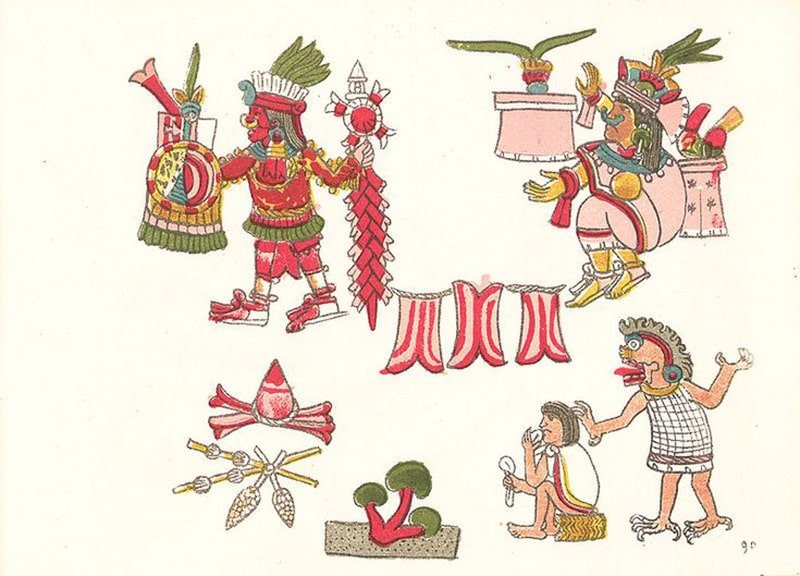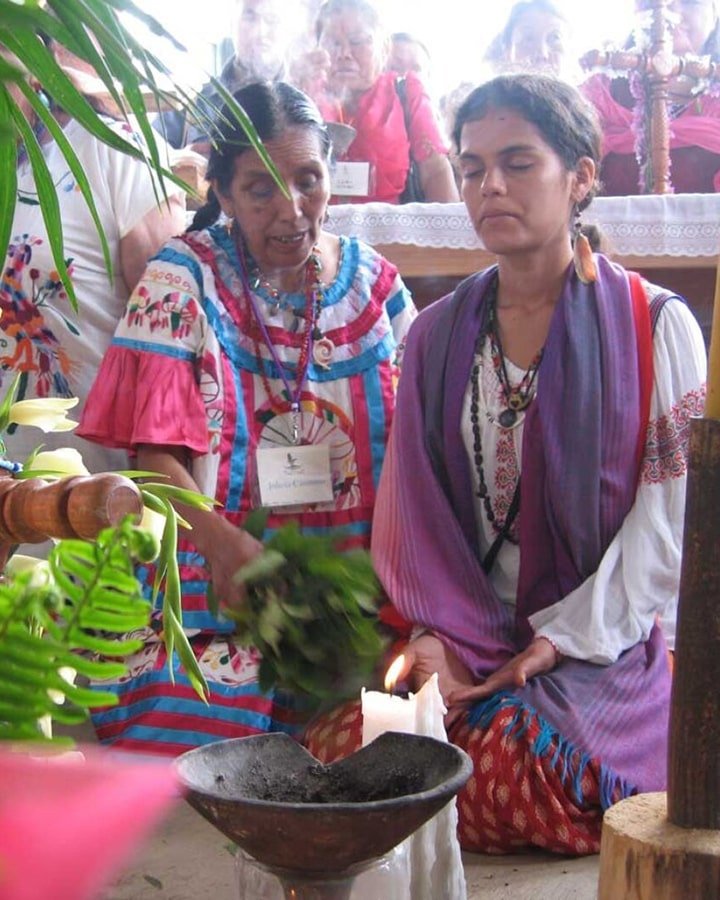A Beginner's Guide to Psychedelic Mushrooms:
The ‘Niños Santos’ (Holy children) of OaxacaIf you’ve stumbled across this article or have found yourself feeling called to learn more about the origin uses of psilocybin and the mushrooms that contain this medicine, consider this an invitation to delve deeper into the world of Mexico’s ancestral relationship with these sacred mushrooms. As the saying goes in Oaxaca, it’s no coincidence that you find yourself here.
Across Mesoamerican cultures, these entheogens have held deep significance and played an essential role in their cosmology, rituals, and medicinal practices. Over generations, these highly advanced cultures accumulated a vast body of indigenous knowledge and science, rooted in their unique bio-cultural context. Psilocybe mushrooms were integrated into the day-to-day reality of Mesoamerican cultures in a variety of ways, including healing, divination, mystical-religious encounters, soul healing, and more.
In this article, we’ll journey through the cultural history and presence of psilocybe mushrooms in some indigenous cultures of Oaxaca, and aim to shed light on the communities that have become centres of “mushroom tourism” and trade. By exploring and honouring indigenous wisdom and the complex interplay of culture, spirituality, colonization, and ecology, we can gain a deeper appreciation for the enduring legacy of these sacred entheogenic mushrooms while cultivating right relationship with them and those who have safeguarded these medicines for millenia.
Throughout this article, the terms “entheogenic mushrooms”, “sacred mushrooms”, and “Psilocybe mushrooms” will be used interchangeably.
The Cultural History of Sacred Entheogenic Mushrooms in Oaxaca
Several codices provide insights into the pre-Hispanic use of sacred mushrooms and other entheogens, including the Magliabechiano Codex, Codex 27, Lienzo de Zacatepec 1, and Vindobonensis Codex. Archaeological evidence also indicates the widespread use of Psilocybe mushrooms across Mesoamerica and civilizations of South America.


Ceremony of Sacred mushroom chaired by the gods 9 Viento (9 Wind, top left) and 7 Flor (7 Flower, top right).
9 Wind sings and plays a ludicrous idiophone over a skull that acts as a resonator.


Glyph named “Nanacatepec” is related to another
codex, the Lienzo de Zacatepec No. 1 from the Mixtec culture
Archaeological Evidence
There are several pieces of archaeological evidence indicating the pre-Hispanic use of Psilocybe as sacred mushrooms, not only in Mexico but also in Mesoamerica and South America. Early information can be found in the cultures of Purépecha and Capacha in western Mexico, Maya culture in southeastern Mexico, and Nahuatl culture in central Mexico.


The Impacts of Colonization
Several colonial chronicles from various regions of ‘La Nueva España’ (“New Spain”) mention sacred mushrooms, providing insights into their significance and use:
- Fernando de Alvarado Tezozómoc’s ‘Crónica Mexicana’ describes the use of mushrooms in sacrificial rituals during Moctezuma II’s ascension to power and how the Spanish gave mushrooms to Moctezuma II upon his capture (1598).
- In 1537, Cortés held a trial against Mixcóatl for practicing the old religion by consuming demonic ‘nanácatl.’
- An appendix of the Códice de Yanhuitlán recounts a case where an indigenous person was accused of invoking the devil using ‘nanacates’ (1544).
- “The ‘Indios’ drink hongos that make them drunk” (1574). A reference to “intoxicating mushrooms” consumed by indigenous peoples.
- ‘Historias de las Indias de la Nueva España e islas de Tierra Firme’ describes the use of mushrooms in ritual sacrifices and the invocation of the devil.
- A Holy Inquisition file in the national archives accuses a young woman of consuming demonic mushrooms (1628).
- In his accounts from the early 17th century, Francisco Hernández referred that despite efforts to eradicate the consumption of entheogenic mushrooms, this practice had not disappeared.

and punishing heresy, which was linked to the Catholic Church.
Indigenous and Bio-cultural Resilience
Two towns in separate regions of Oaxaca have gained particular recognition for their connection to sacred mushrooms and their entheogenic powers; Huautla de Jiménez and San José del Pacífico.


Huautla de Jiménez
The ritual use of entheogenic mushrooms gained widespread attention around 1960 due to María Sabina Magdalena García, a local healer who became the focus and fascination of researchers such as Gordon Wasson, Gutierre Tibón, Fernando Benítez, and Salvador Roquet. Their work introduced these practices to the attention of the Western public by exhibiting the ancestral rituals they experienced with Maria Sabina in various articles, and as a consequence, unexpectedly boosting national and international tourism to the region in search of the healer and sacred mushrooms.
San José del Pacífico
Psilocybin mushrooms thrive in the dark, cool ravines of these forested mountains and can be found in abundance during the rainy season. The locals of San Miguel Suchixtepec, San Mateo Río Hondo, San Sebastián Río Hondo, and San José del Pacífico have maintained a relationship with sacred mushrooms since their earliest settlements. Very little research has been done on the healing properties of sacred mushrooms in southern Oaxaca but, definitely the exploration in the Sierra Mazateca gave way to the study of fungy in other regions of Oaxaca such as the South Sierra and the Coast.

Sacred Mushroom Rituals and Ceremonies
Huautla de Jiménez
Before participating in a ceremony, one must undergo a preparation process that includes:
Meditation to reflect on one’s life experiences and practicing sexual abstinence as a fundamental requirement for ingesting sacred mushrooms. Adhering to a diet that avoids animal products, processed foods, fats, irritants, alcohol, and drugs to ensure purity is also essential.
Participants then attend the Mazatec ‘velada’, where they receive a ‘limpia’ (ritual cleansing) involving copal, herbs, and local soil. The ceremony takes place in the home of the ‘curandera’ facing an altar that showcases the syncretism in this ancient ritual. Images and figures of Jesus Christ and the Virgin Mary intermingle with ancestral ritual elements such as copaleros, cacao seeds, maize offerings, clay vessels, and more. Fresh mushrooms are consumed, followed by a series of petitions to God, nature beings, Catholic saints, and deceased family members in both Spanish and the indigenous Mazatec language. These prayers serve to establish a personal connection with God and to set intentions and objectives for the ceremony. The “curandera” acts as an intermediary for participants who consume the sacred mushrooms to present themselves before God. Typically, all participants in the ceremony – a maximum of four or five people – share the mushroom experience.

San José del Pacífico
The elders mention to offerings to the deity of the lightning that are made after the collection of sacred mushrooms; it is a thanksgiving that is given to three beings or entities: the Earth, the Great Lightning and the Sacred mushrooms. The inhabitants refer to the sexual union between the beam that carries the sperm and Mother Earth that is filled with vitality and strength with this act, so that the holy children are the miraculous product of such encounter.
In this region, disease is conceived as an imbalance of the person with his natural, social and/or cultural environment, so that the individual can become sick by the forces of nature, by spells and other violations of the norms of his traditions. This is where traditional doctors, healers, witches or shamans come into action, because unlike a Western doctor, they diagnose the evil in relation not only to the social and cultural natural environment but to the world overnatural and often remedy it with the help of fungi.
A local story passed down by grandparents and residents recounts how a total solar eclipse in 1970 drew the attention of nationals and foreigners visiting the town of Miahuatlán and its surroundings. The visitors were captivated by the beauty of the landscape and its sites, marking the beginning of tourism in the town of San Jose del Pacifico. The area is home to majestic pine and oak forests as well as psilocybe mushrooms.
Locals here report having consumed sacred mushrooms as children, some innocently and others at the encouragement of their parents and grandparents. The ritual here is simply described as “walking in the forest”, “getting lost until you find yourself”, or “walking down the mountain”. This connection to the mountain and its wisdom remains strong.

Considering visiting Huautla de Jiménez or San Jose del Pacifico?
Choosing between Huautla de Jiménez and San José del Pacífico for a mushroom retreat ultimately depends on your personal preferences, priorities, and what you hope to gain from the experience. Here’s a brief overview of what each community has to offer:
Visiting a Curandera in Huautla for a Mazatec Velada:
This trip is ideal for people with a deep interest in Mesoamerican and Mazatec culture and their preservation, curious individuals who appreciate different ways of thinking and living, and those seeking self-discovery and healing of the mind, body, heart and soul.
How to prepare for a Mazatec velada

Before or after your psychedelic experience, explore the mountain’s scenic trails, enjoy stunning views of the Sierra Mazateca, clouds, and landscapes. You can immerse yourself in the mountains and discover rivers and waterfalls that will create an unforgettable experience of communion with nature.
Connecting to the Medicine of the Mountain in San José del Pacífico
The power of sacred mushrooms doesn’t depend on reviews or likes; be curious of the spirit of sacred entheogens like Psilocybe mushrooms, ask questions, suggest that they teach you about the mushrooms, inspect their condition and freshness, feel, and decide if they’re right for you. A good option to connect to your present inner landscape is to participate in a traditional temazcal ceremony before ingesting entheogenic mushrooms.
How to prepare for a personal mushroom ceremony
This trip is perfect for solo travelers, friends, or family members who want an intimate experience where the land guides each individual with its visible and subtle wisdom. Take a stroll through the mountain trails that are allowed, enjoy streams and waterfalls. Mother Nature will embrace you. Feel her breath and unconditional love.


